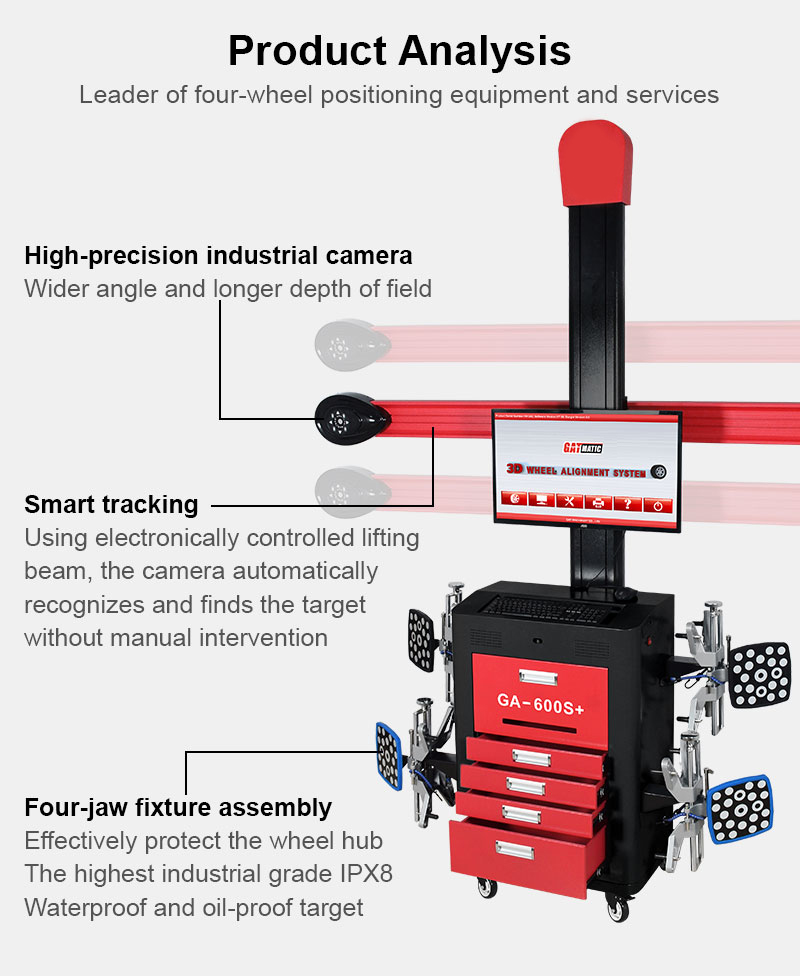Recent Blog
-
CCD Alignment Systems VS. 3D Alignment Systems
2025-04-08 -
What are the main differences between 2D and 3D wheel alignment systems
2025-03-26 -
Is Touchless Wheel Alignment Right for You? Factors to Consider
2025-03-19 -
The Future of Automotive Service: Exploring Touchless Wheel Alignment Technology
2025-03-13
What are the benefits of 3D wheel alignment systems over traditional methods?
In the realm of automotive maintenance, precision is paramount. Ensuring that wheels are properly aligned not only enhances vehicle performance but also guarantees safety on the road. Over the years, technological advancements have revolutionized the process of wheel alignment, with 3D wheel alignment systems emerging as a superior alternative to traditional methods. This essay explores the manifold benefits of 3D wheel alignment systems over their conventional counterparts.
I. Accuracy and Precision
One of the most significant advantages of 3D wheel alignment systems lies in their unparalleled accuracy and precision. Unlike traditional methods that often measure one angle at a time, 3D systems have the capability to measure all angles simultaneously. By utilizing advanced sensor technology and sophisticated algorithms, 3D systems provide comprehensive and precise alignment data, ensuring optimal vehicle performance and safety. Studies have consistently shown that vehicles aligned using 3D systems exhibit fewer alignment-related issues compared to those aligned using traditional methods.
II. Efficiency and Speed
Another compelling benefit of 3D wheel alignment systems is their remarkable efficiency and speed. Traditional alignment methods typically involve manual adjustments and repeated measurements, leading to time-consuming processes. In contrast, 3D systems streamline the alignment process by automating measurements and calculations, significantly reducing alignment time. Mechanics can swiftly identify alignment issues and make necessary adjustments with greater efficiency, thereby improving productivity and customer turnaround times.
III. Versatility and Adaptability
3D wheel alignment systems also excel in terms of versatility and adaptability. Unlike traditional methods, which may have limitations in vehicle compatibility, 3D systems are designed to handle a wide range of vehicles and wheel configurations. Whether it’s passenger cars, trucks, or specialty vehicles, 3D systems can accurately align wheels regardless of size or model. This versatility not only enhances the service capabilities of automotive workshops but also ensures that all customers receive precise and tailored alignment solutions.
IV. Ease of Use and Training
Furthermore, 3D wheel alignment systems offer unparalleled ease of use and require minimal training. With intuitive software interfaces and user-friendly features, mechanics can quickly familiarize themselves with the operation of 3D systems, reducing the learning curve associated with traditional alignment methods. This ease of use not only enhances operational efficiency but also enables automotive workshops to optimize their workforce and allocate resources more effectively.
V. Technological Advancements
The technological advancements incorporated into 3D wheel alignment systems further underscore their superiority over traditional methods. Features such as wireless sensors, automatic tracking, and real-time diagnostics empower mechanics to perform alignments with unprecedented accuracy and efficiency. These advanced capabilities not only simplify the alignment process but also enable proactive maintenance and predictive analysis, thereby minimizing the risk of alignment-related issues and prolonging the lifespan of vehicle components.
VI. Cost-effectiveness
Finally, 3D wheel alignment systems offer compelling cost-effectiveness benefits over traditional methods. While the initial investment in 3D systems may be higher, the long-term savings in labor costs, rework, and customer satisfaction far outweigh the upfront expenses. Studies have shown that vehicles aligned using 3D systems experience reduced tire wear, improved fuel efficiency, and enhanced driving comfort, resulting in lower maintenance costs and higher customer retention rates.
Conclusion
In conclusion, 3D wheel alignment systems represent a significant advancement in automotive maintenance technology, offering a myriad of benefits over traditional alignment methods. From superior accuracy and efficiency to versatility and cost-effectiveness, 3D systems empower automotive workshops to deliver exceptional alignment services and enhance customer satisfaction. As technology continues to evolve, the adoption of 3D wheel alignment systems is poised to become the new standard in the automotive industry, revolutionizing the way vehicles are serviced and maintained.
FAQs
1. What is a 3D wheel alignment system, and how does it differ from traditional methods?
A 3D wheel alignment system utilizes advanced sensor technology to simultaneously measure multiple wheel angles, providing comprehensive alignment data. In contrast, traditional methods typically measure one angle at a time, resulting in a more time-consuming process.
2. How accurate are 3D wheel alignment systems compared to traditional methods?
3D wheel alignment systems offer superior accuracy and precision, thanks to their ability to measure all angles simultaneously. Studies have shown that vehicles aligned using 3D systems experience fewer alignment-related issues compared to those aligned using traditional methods.
3. Are 3D wheel alignment systems compatible with all types of vehicles?
Yes, one of the advantages of 3D systems is their versatility and adaptability. They can handle a wide range of vehicles, including passenger cars, trucks, and specialty vehicles, regardless of size or model.
4. Do 3D wheel alignment systems require specialized training for mechanics?
While some training may be necessary to familiarize mechanics with the operation of 3D systems, they generally offer intuitive interfaces and user-friendly features, reducing the learning curve associated with traditional alignment methods.
5. How do 3D wheel alignment systems contribute to efficiency and speed in automotive workshops?
3D systems streamline the alignment process by automating measurements and calculations, significantly reducing alignment time. Mechanics can quickly identify alignment issues and make necessary adjustments with greater efficiency, improving productivity and customer turnaround times.
6. What technological advancements do 3D wheel alignment systems offer?
3D wheel alignment systems incorporate advanced features such as wireless sensors, automatic tracking, and real-time diagnostics, enhancing accuracy, efficiency, and ease of use. These features enable proactive maintenance and predictive analysis, minimizing the risk of alignment-related issues.
Describe Your Needs In Detail!
We will carefully evaluate your needs and give professional solutions.



